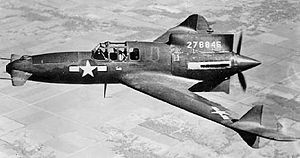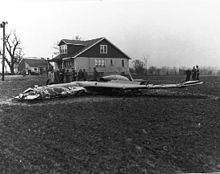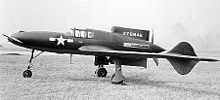- Curtiss-Wright XP-55 Ascender
-
XP-55 Ascender Curtiss XP-55 Ascender in flight. Role Fighter Manufacturer Curtiss-Wright Corporation First flight 19 July 1943 Status Cancelled Number built 3 The Curtiss-Wright XP-55 Ascender (company designation CW-24) was a 1940s United States prototype fighter aircraft built by Curtiss-Wright. Along with the XP-54 and XP-56, it resulted from United States Army Air Corps proposal R-40C issued on 27 November 1939 calling for unconventional aircraft designs. A highly unusual design for its time, it had a canard configuration, a rear mounted engine, swept wings and two vertical tails. Because of its pusher design, it was sarcastically referred to as the "Ass-ender".[1] Like the XP-54, the Ascender was initially designed for the Pratt & Whitney X-1800 engine and had to be redesigned when that engine project was cancelled. It would also be the first Curtiss fighter aircraft to use tricycle landing gear.
Contents
Design and development
On 22 June 1940, the Curtiss-Wright company received an Army contract for preliminary engineering data and a powered wind tunnel model. The designation P-55 was reserved for the project. The USAAC was not completely satisfied with the results of these tests and Curtiss-Wright took it upon itself to build a flying full-scale model which it designated CW-24B. The flying testbed was powered by a 275 hp (205 kW) Menasco C68-5 inline engine. It had a fabric-covered, welded steel tube fuselage with a wooden wing. The undercarriage was non-retractable.
On 10 July 1942, the United States Army Air Forces issued a contract for three prototypes under the designation XP-55. Serial numbers were 42-78845 through 42-78847. During this time the Pratt & Whitney X-1800 engine was experiencing serious developmental delays, and would eventually be cancelled. Curtiss decided to switch to the Allison V-1710 (F16) liquid-cooled inline engine (rated at 1,000 hp/746 kW) because of its proven reliability. Armament was to be two 20 mm (.79 in) cannon and two 0.50 in (12.7 mm) machine guns. During the mock-up phase, it was decided to switch to the more powerful 1,275 hp (951 kW) Allison V-1710-95 engine. The 20 mm (.79 in) cannon were also replaced by 0.50 in (12.7 mm) machine guns.
A special feature of the XP-55 was a propeller jettison lever located inside the cockpit to prevent the pilot from hitting the propeller during bailout.
Operational history
The first XP-55 (42-78845) was completed on 13 July 1943 and had the same aerodynamic configuration as the final prototype CW-24B. The aircraft made its first test flight on 19 July 1943 from the Army's Scott Field near the Curtiss-Wright plant in St Louis, Missouri. The pilot was J. Harvey Gray, Curtiss' test pilot. Initial testing revealed that the takeoff run was excessively long. To solve this problem the nose elevator size was increased and the aileron up trim was interconnected with the flaps so that it operated when the flaps were lowered.
On 15 November 1943 test pilot Harvey Gray, flying the first XP-55 (S/N 42-78845), was testing the aircraft's stall performance at altitude when the XP-55 suddenly flipped over on its back and fell in an uncontrolled, inverted descent. The pilot was unable to right the airplane, and it fell out of control for 16,000 feet (4,900 m) before Gray was able to parachute to safety. The aircraft was destroyed.
The second XP-55 (S/N 42-78846) was similar to the first but with a slightly larger nose elevator, modified elevator tab systems, and a change from balance tabs to spring tabs on the ailerons. It flew for the first time on 9 January 1944. All flight tests were restricted so that the stall zone was avoided.
The third XP-55 (S/N 42-78847) flew for the first time on 25 April 1944. It was fitted with four machine guns, and incorporated some of the ideas learned from the loss of the first XP-55. It was found that the aircraft's stall characteristics could be greatly improved by the addition of four-foot wingtip extensions, and by increasing the limits of the nose elevator travel. Between 16 September and 2 October 1944, the second XP-55 (42-78846), which had been modified to the same standards as the third aircraft, underwent official USAAF flight trials.
The performance of the XP-55 was not very impressive and was often inferior to that of more conventional fighter aircraft already in service.[citation needed] In addition, by 1944 jet-powered fighter aircraft were already well along in development and there was no further development of the XP-55.
The third prototype XP-55 (s/n 42-78847) was lost on 27 May 1945 during the closing day of the Seventh War Bond Air Show at Wright Field in Dayton, Ohio.[2]
Aircraft on display
- XP-55 Ascender, s/n 42-78846, is on display at at the Air Zoo in Kalamazoo, Michigan. It is on long-term loan from the Smithsonian's National Air and Space Museum in Washington D.C..[3]
Specifications (XP-55)
Data from WW2 Aircraft Fact Files: US Army Air Force Fighters, Part 1 [4]
General characteristics
- Crew: one pilot
- Length: 29 ft 7 in (9.0 m)
- Wingspan: 40 ft 7 in (12.4 m)
- Height: 10 ft 0 in (3.0 m)
- Wing area: 235 ft² (21.83 m²)
- Empty weight: 6,354 lb (2,882 kg)
- Loaded weight: 7,710 lb (3,497 kg)
- Max takeoff weight: 7,930 lb (3,600 kg)
- Powerplant: 1 × Allison V-1710-95 liquid-cooled V12 engine, 1,275 hp (951 kW)
Performance
- Maximum speed: 390 mph at 19,300 ft (628 km/h)
- Service ceiling: 34,600 ft (10,500 m)
Armament
- Four 0.50-inch machine guns in the nose
See also
- Aircraft of comparable role, configuration and era
- Northrop XP-56
- Vultee XP-54
- Ambrosini SS.4
- Henschel P.75
- Kyushu J7W
- Miles Libellula
- Saab 21
- Related lists
- List of military aircraft of the United States
- List of fighter aircraft
- List of airshow accidents
References
- Notes
- ^ Jenkins 2008. p. 8
- ^ Blazer 2008
- ^ "XP-55 Ascender/42-78846" National Air and Space Museum Retrieved: 13 June 2011.
- ^ Green and Swanborough 1977, pp. 69–71.
- Bibliography
- Balzer, Gerald H. American Secret Pusher Fighters of World War II: XP-54, XP-55, and XP-56. North Branch, Minnesota: Specialty Press, 2008. ISBN 1-58007-125-2.
- Bowers, Peter M. Curtiss Aircraft, 1907-1947. London: Putnam 7 Company Ltd., 1979. ISBN 0-370-10029-8.
- Green, William. War Planes of the Second World War, Volume Four: Fighters. London: MacDonald & Co. (Publishers) Ltd., 1961 (Sixth impression 1969). ISBN 0-356-01448-7.
- Green, William and Gordon Swanborough. WW2 Aircraft Fact Files: US Army Air Force Fighters, Part 1. London: Macdonald and Jane's Publishers Ltd., 1977. ISBN 0-356-08218-0.
- Jenkins, Dennis R. and Tony R. Landis. Experimental & Prototype U.S. Air Force Jet Fighters. North Branch, Minnesota: Specialty Press, 2008. ISBN 978-1-58007-111-6.
- McIntyre, Violet. Niagara Gazette, Niagara Falls, NY, 11 November 2004.
External links
- NMUSAF - Curtiss XP-55
- NASM article
- The Plan Page - Curtiss XP-55 Ascender
- XP-55 Ascender
- USAAF Resource Center - Curtiss XP-55
- Dayton Air Show History
- "Flying Backwards to the Future", Popular Science, August 1945
Aircraft produced by Curtiss and Curtiss-Wright Manufacturer
designationsModel letters: C • D • E • F • G • GS • H • J • K • L • M • N • PN • JN • R • S
Model numbers: 1 • 2 • 3 • 4 • 5 • 6 • 7 • 8 • 9 • 10 • 11 • 12 • 13 • 14 • 16 • 17 • 18 • 19 • 20 • 21 • 23 • 24 • 26 • 28 • 31 • 32 • 33 • 34 • 35 • 36 • 37 • 38 • 39 • 40 • 41 • 42 • 43 • 44 • 47 • 48 • 49 • 50 • 51 • 52 • 53 • 54 • 55 • 56 • 57 • 58 • 59A/59B • 60 • 61 • 62 • 63 • 64 • 66 • 67 • 68 • 69 • 70 • 71 • 72 • 73 • 75 • 76 • 77 • 79 • 81 • 82 • 84 • 85 • 86 • 87 • 88 • 90 • 91 • 94 • 95 • 96 • 97 • 98 •
"CW" models: CW-1 • CW-2 • CW-3 • CW-4 • CW-5 • CW-6 • CW-7 • CW-8 • CW-9 • CW-10 • CW-11 • CW-12 • CW-14 • CW-15 • CW-16 • CW-17 • CW-18 • CW-19 • CW-20 • CW-21 • CW-22 • CW-23 • CW-24 • CW-25 • CW-27 • CW-29 • CW-32
By role Experimental: No. 1 • Model C • Tanager
Racing: No. 2 • CR • R2C • R3C
General utility: Model D • Model E • Model F • Robin • Thrush
Maritime patrol: Model H • HS-1L and -2L
Training: Model L • Model JN • Fledgling • AT-4 Hawk • AT-5 Hawk
Fighters: 18 • PW-8 • P-1 • P-2 • P-3 • P-4 • P-5 • P-6 • XP-31 • P-36 • P-40 • XP-46 • XP-53 • YP-60 • XP-62 • XP-71 • XP-87
Naval Fighters: HA • FC • F2C • F3C • F4C • F6C • F7C • F8C • F9C • F10C • F11C • XF12C • F13C • XF14C • XF15C
Airliners: Eagle • Condor II • Kingbird
Naval Scouts/Dive Bombers: CS • GS • S2C • XS3C • S4C • SC • SBC • SB2C • XSB3C • SOC • SO2C • SO3C
Observation: O-1 • O-12 • O-13 • O-16 • O-18 • O-26 • O-39 • O-40 • O-52
Naval Observation: OC • O2C • O3C
Naval Bombers: 24 • BFC • BF2C • XBTC • XBT2C
Ground Attack: A-3 • A-4 • A-5 • A-6 • A-8 • YA-10 • A-12 • YA-14 • A-25 • A-40 • XA-43
Licensed production: NBS-1
USAAS/USAAC/USAAF/USAF fighter designations 1924–1962 Pursuit (pre-1948)
Fighter (post-1948)P-1 • P-2 • P-3 • XP-4 • P-5 • P-6 • XP-7 • XP-8 • XP-9 • XP-10 • P-11 • P-12 • XP-13 • XP-14 • XP-15 • P-16 • XP-17 • XP-18 • XP-19 • YP-20 • XP-21 • XP-22 • XP-23 • YP-24 • Y1P-25 • P-26 • YP-27 • Y1P-28 • P-29 • P-30 • XP-31 • XP-32 • XP-33 • XP-34 • P-35 • P-36 • XP-37 • P-38 • P-39 • P-40 • XP-41 • XP-42 • P-43 • P-44 • XP-45 • XP-46 • P-47 • XP-48 • XP-49 • XP-50 • P-51 • XP-52 • XP-53 • XP-54 • XP-55 • XP-56 • XP-57 • XP-58 • P-59 • YP-60 • P-61/RF-61C • XP-62 • P-63 • P-64 • XP-65 • P-66 • XP-67 • XP-68 • XP-69 • P-70 • XP-71 • XP-72 • XP-73 • (P-74 not assigned) • P-75 • XP-76 • XP-77 • XP-78 • XP-79 • P-80 • XP-81 • P-82 • XP-83 • P-84 • XP-85 • P-86/F-86D • XP-87 • XP-88 • P-89 • XF-90 • XF-91 • XF-92 • YF-93 • F-94 • YF-95 • YF-96 • F-97 • XF-98 • F-99 • F-100 • F-101 • F-102 • XF-103 • F-104 • F-105 • F-106 • F-107 • XF-108 • XF-109 • F-110 • F-111/F-111B
Pursuit, Biplace Fighter, Multiplace YFM-1 • XFM-2
Lists relating to aviation General Aircraft (manufacturers) · Aircraft engines (manufacturers) · Airlines (defunct) · Airports · Civil authorities · Museums · Registration prefixes · Rotorcraft (manufacturers) · TimelineMilitary Accidents/incidents Records Categories:- Curtiss aircraft
- United States fighter aircraft 1940–1949
- Single-engined pusher aircraft
- Canard aircraft
- Cancelled military aircraft projects of the United States
Wikimedia Foundation. 2010.



